Choosing the Right Polycarbonate Membrane: Answers to Common Questions

Polycarbonate membranes, known for their precision, durability, and an extensive range of applications, have been at the forefront of numerous groundbreaking discoveries and innovations. However, navigating the nuances of this unique track-etched membrane can be complex, often accompanied by questions. Below, we've curated a comprehensive guide to address the most common inquiries and provide valuable insights into the features, benefits, and uses of polycarbonate track-etched (PCTE) membranes.
Q. How are polycarbonate membranes made?
A. Polycarbonate membranes are made using track-etching technology that begins by subjecting thin polymer films to high-energy particle irradiation. This process results in the creation of latent tracks, which are subsequently transformed into well-defined pores through a specialized chemical treatment. Variations of the membrane extend broad use across several applications.
Q: How clear are the polycarbonate track-etched membranes?
A: Generally, polycarbonate membranes are thin and translucent. Depending on pore size rating and pore density, the filters may appear transparent or may appear opaque. For additional clarity on the topic, refer to this previous article.
In some instances, when PCTE membrane filters with standard specifications appear opaque, Sterlitech can provide custom low pore density filters with the same pore size rating that are transparent. For comparison, most conventional microporous membrane filters are considerably thicker and cannot be made transparent.
Q: How do I know when to use a standard, dyed, PVP-Free or gold polycarbonate membrane?
A: Filtration Needs:
- Standard Polycarbonate Membrane: This is a versatile choice for many applications. If you have typical filtration needs and don't require any specialized characteristics, standard polycarbonate membranes are often suitable.
- Gold Polycarbonate Membrane: Use a gold polycarbonate membrane if you require enhanced contrast for particle analysis. The gold-coated surface provides excellent visibility under microscopy, making it suitable for applications like particle counting and sizing.
- Biological Applications:
- PVP-Free Polycarbonate Membrane: If you're working with biological samples or applications involving proteins or nucleic acids, PVP-Free membranes are a better choice. PVP (polyvinylpyrrolidone) can interfere with biological assays, so using a PVP-Free membrane helps ensure accurate results.
- Visibility and Imaging:
- Dyed Polycarbonate Membrane: Dyed polycarbonate membranes are often used for applications where visibility or imaging is essential. The color contrast can aid in locating specific particles or structures under the microscope. Choose a dyed membrane if you need this visual aid in your work.
Q: Do cells adhere to the surface of polycarbonate membranes?
A: Depending on the cell line, most exfoliated human cells adhere with some tenacity. Most epithelial cells will adhere if the membrane has a negative charge applied by gas plasma or has a suitable attractant applied to the surface of the membrane. Endothelial cells will generally not attach to the surface of Track Etch membranes.
Q: What formats are polycarbonate membranes available in?
A: Polycarbonate membranes can be purchased in pre-cut disks, sheets, and roll stock.
Q: I don’t see the specific size I want listed. Can you provide a custom option?
A: Yes! Contact us and we can find a solution for your application.
- Most Viewed Blog Articles (5)
- Company News (284)
- Emerging Technologies (64)
- Microbiology and Life Science News (93)
- Water and Fluid Separation News (97)
- Filtration Resources (93)
- Product News (19)

![Join Sterlitech at BIO 2024 [Booth #5558]: Exploring the Future of Biotechnology](https://www.sterlitech.com/media/blog/cache/300x200/magefan_blog/b4.jpeg)




